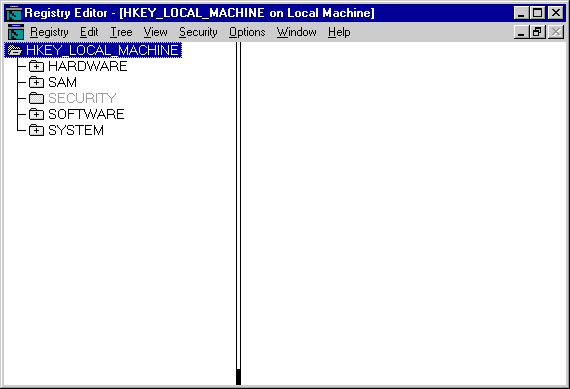| Maintenance and Troubleshooting | << | >> |
Automatic Logon and Startup
If you need your messaging system to run 24 hours a day, monitors should also run 24 hours a day. Power surges or outages can restart computers. When this happens, the computer must log on and start the monitor without assistance.
Logging On to Windows NT Server Automatically
If there is a power failure, no one may be available to log on to Windows NT Server when the power is restored. In this case, you can configure Windows NT to log on automatically at startup.
Important The Windows NT Server account configured to automatically log on at startup should be an account that has at least user-level permission on the monitors. It must also have sufficient permission for notification alerts and programs and for any escalation or clock synchronization actions to be taken.
- From the Start menu, choose Run.
- In the Open box, type REGEDT32.EXE, and then choose OK to start the Registry Editor.

- From the Window menu, choose HKEY_LOCAL_MACHINE, and then open the following subkey:
SOFTWARE\Microsoft\Windows NT\CurrentVersion\Winlogon
- If the AutoAdminLogon entry appears in the subkey, double-click the entry and skip to step 7. If it does not appear, choose Add Value from the Edit menu.
- In the Value Name box, type AutoAdminLogon.
- In the Data Type box, select REG_SZ, and then choose OK.
- In the String box, type 1, and then choose OK.
- From the Edit menu, choose Add Value.
- In the Value Name box, type DefaultPassword.
- In the String box, type the password for the default user, and then choose OK.
- Check the string values of the entries LegalNoticeCaption and LegalNoticeText. If there is any text in either of these entries, you must remove it for automatic logon to occur.
- From the Registry menu, choose Exit to save the changes and close the Registry Editor.
Starting Link and Server Monitors Automatically
Link and server monitors can be set to restart automatically when the Administrator program is started. This makes administration easier by not requiring you to manually start each monitor at startup.
- From the Start menu, choose Settings.
- Choose Taskbar, and then select the Start Menu Items tab.
- Choose Add, and then choose Browse.
- Locate the Microsoft Exchange Server Admin.exe program, and then double-click the program icon. This program is usually located in the \Exchsrvr\bin subdirectory.
- In the Command Line box, add the /m option with the site name, monitor name, and server name in the following format:
path\admin.exe /m[site name]\monitor name\server name
For example, the complete command line could read:
c:\Exchsrvr\Bin\admin.exe /mNAmerica-W\Head Office Servers\Alpha103
Multiple monitors can be started on the same command line by adding additional \monitor name\server name entries in step 5, above. For example:
c:\Exchsrvr\Bin\admin.exe /mBerlin\server1 /mBerlinLink1\server1 /mParisLink2\server1 /mBerlinLink3\server1
- Choose Next, and then double-click the StartUp folder.
- Type the name that you want to see on the StartUp menu, and then choose Finish.
- In the Taskbar Properties window, click OK.
| Option
| Description
|
|
Path |
Full path to the Bin directory where the Administrator program is installed. |
|
Site name |
The name of the site where the monitor is defined, not where it runs. This parameter is optional. |
|
Monitor name |
The directory name of the monitor to be started. |
|
Server name |
The name of the server you want to read the monitor and perform all other operations requiring a home server, for example, sending mail. |
Starting Performance Monitor Automatically
Performance Monitor can also be added to the StartUp folder, but the command-line argument is limited to one file. This is an alert file (.pma) that has been created, configured, and saved earlier.
- From the Start menu, choose Settings.
- Choose Taskbar, and then select the Start Menu Items tab.
- Choose Add, and then choose Browse.
- Locate the Windows NT Server Performance Monitor program (Perfmon.exe), and then double-click the program icon. This program is usually located in the Winnt\System32 subdirectory.
- In the Command Line box, add the path and file name for the Performance Monitor alert file. Use the following format:
perfmon.exe path\filename
where path\filename is the path and file name of a Performance Monitor alert file.
- Choose Next, and then double-click the StartUp folder.
- Type the name that you want to see on the StartUp menu, and then click Finish.
- In the Taskbar Properties window, choose OK.
For more information on creating and configuring alert files, see "Adding Selections to an Alert Log" earlier in this chapter.

